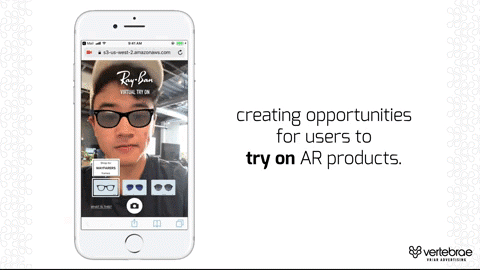
Editor’s note: The original headline of this piece was inaccurate and has been updated to reflect the story. We apologize for the error.
With support from both Apple and Google, augmented reality could become the technology of choice for advertisers and marketers, as demonstrated by the immense popularity of Snapchat Lenses and camera effects on Facebook. However, AR has been limited to dedicated apps and social media platforms, which impacts their overall accessibility. But advertising platform Vertebrae announced a solution that will bring AR to the masses—an ad suite that launches AR experiences directly from users’ mobile web browsers.
“We’ve had display, banner and video ads since the dawn of TV, so we see AR and VR as new mediums that provide unique and differentiated value to advertisers,” Vertebrae founder and CEO Vince Cacace told AListDaily. “They create experiences in new, personalized and contextual ways. With our new AR suite of products, we’ve taken our first step into the world of AR.”
Vertebrae’s previous efforts have largely focused on VR, including the creation of a native VR ad network that reaches nearly three million people a month. That’s in addition to working with publishers such as Forbes, Time and Hearst to develop 360-degree videos for the web and mobile devices. Based on that experience, the company is now it is turning its attention to AR.
“We saw a lot of scale on the web and mobile piece because everybody has a cell phone,” said Cacace. “So, with this AR suite, we tried to figure out what else we could deliver that provides a differentiated user experience but has a lot of scale potential.”
Vertebrae’s AR ad would appear like any other banner or display ad on a website, except that it expands into an AR ad experience right from the browser. These experiences cover multiple formats that include “try on,” where users can put on a pair of virtual sunglasses using their phones—blending the physical and digital worlds and possibly removing the need for a physical product to be present for purchasing decisions. Other experiences include “car ad,” where users can check out the interior of a vehicle or see how it looks in their driveways while changing its colors and walking around it. Entertainment companies may be the most interested in the selfie filters, which are like traditional Snapchat Lenses, but aren’t limited to a specific social platform.
“With the AR ad suite, we’re essentially enabling AR right over the mobile web browser,” Cacace explained. “We think that’s important because previously, for companies to use AR for advertising, they had to do it in an app-based experience. There’s a lot of friction to having an experience like that because you need to make a consumer download an app or point them to a third-party app. What we’re able to do is serve ads over the web, where users just need to allow camera access to have the augmented experience.”
Cacace said that he thinks of it as advertising outside of the walled garden, giving advertisers much more freedom. However, assets can be brought to other platforms such as Facebook or Snapchat if they wish to. He also added that the Vertebrae ads take advantage of existing adtech stacks, so advertisers still get all the data and recording capabilities that they’re accustomed to in addition the new camera and event data.
Although there are some impressive AR apps out right now, chief among them being Pokémon GO, Cacace believes that developers are still figuring out what works in the app space.
“There are some great ‘adverAR’ apps out there, like the ones by Ikea and Porsche,” he said. “But the hard part for an advertiser is getting people to the app. There are a lot of people who have app fatigue and don’t want to download an advertising experience.”
“There are a lot of people who have app fatigue and don’t want to download an advertising experience.” — Vince Cacace, Vertebrae founder and CEO
But that doesn’t mean that these ads will necessarily replace AR apps.
“Apps provide a richer and deeper experience,” Cacace admitted. “In an ad, you have size constraints, depending on how fast you want the experience to load. Therefore, it wouldn’t make sense to bring Ikea’s entire catalogue in. You’d also be missing the advanced interactive capabilities something like ARKit enables. So, there are trade-offs, but we see the scale factor of the web outweighing them because we can still deliver a high-quality experience.”
 Cacace believes that instead of replacing apps, Vertebrae could supplement them by driving discovery.
Cacace believes that instead of replacing apps, Vertebrae could supplement them by driving discovery.
“They could have a smaller version of the app that lives as an ad that drives people to download the app,” he said. “An example of that would be taking one couch from Ikea and letting people place it in their living rooms, then directing them to the app for the full catalogue.”
Vertebrae’s AR suite does not take advantage of advanced AR hardware such as Google Tango, with Cacace stating, “We’re focused on the widest use cases possible, which don’t require things like ARKit or ARCore. Things all happen within the browser, so you don’t need special hardware to view any of the ads.”
However, a big focus for Vertebrae is delivering AR at scale, which seems to be happening quickly. About 50 percent of iPhone users have upgraded to iOS 11, so the technology already captures half of the Apple market. As for Android, the ads will work on version 5.0 of the operating system or better, but because there’s a lot of inventory available with newer devices, Vertebrae has been leaning more toward Android 6.0.
Cacace also discussed the topic of location tracking in AR experiences to drive users to destinations, similar to Pokémon GO.
“Theoretically, an advertiser could put a marker or tracker to cue part of an experience,” he said. “We can also have interactions based on real-world objects. The other thing that we’re doing with location seeing effectiveness, like whether they walk into a store after seeing an AR ad.”

